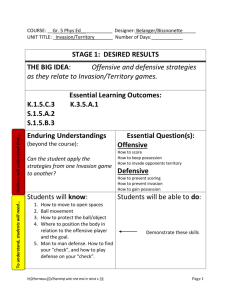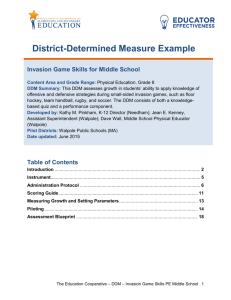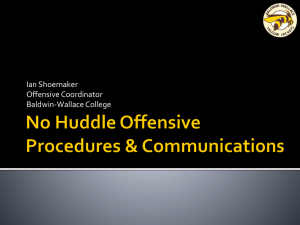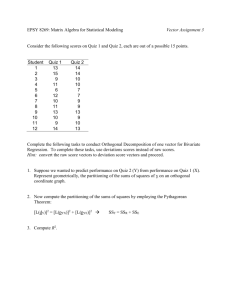Example Common Measure: Development Report Invasion Game
advertisement
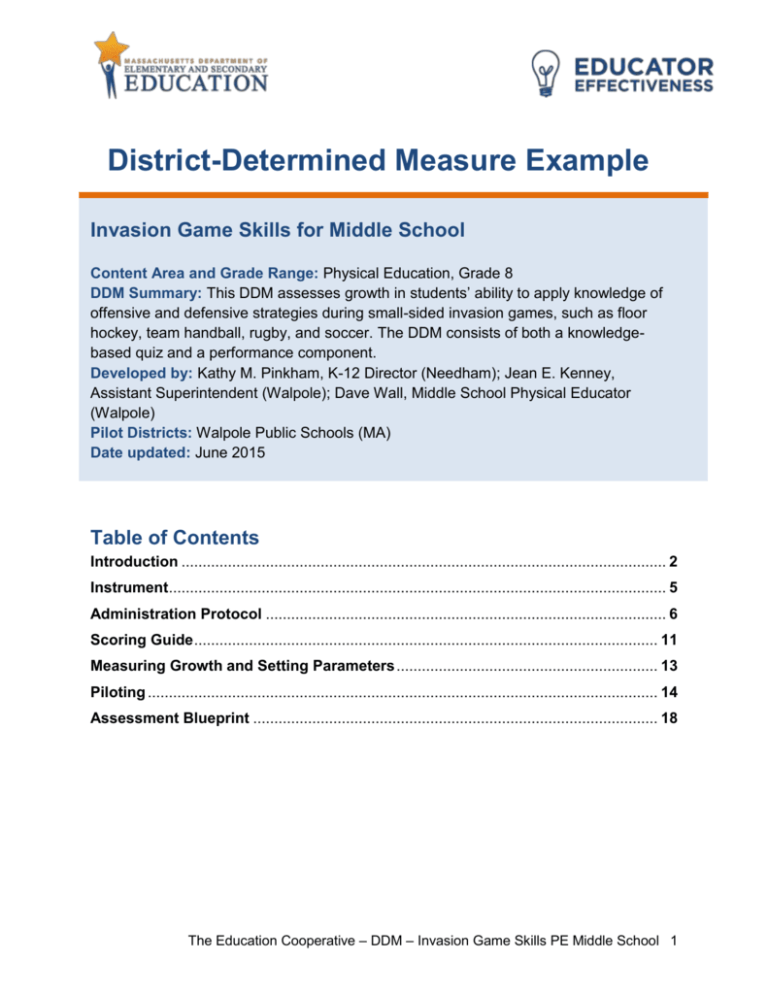
District-Determined Measure Example Invasion Game Skills for Middle School Content Area and Grade Range: Physical Education, Grade 8 DDM Summary: This DDM assesses growth in students’ ability to apply knowledge of offensive and defensive strategies during small-sided invasion games, such as floor hockey, team handball, rugby, and soccer. The DDM consists of both a knowledgebased quiz and a performance component. Developed by: Kathy M. Pinkham, K-12 Director (Needham); Jean E. Kenney, Assistant Superintendent (Walpole); Dave Wall, Middle School Physical Educator (Walpole) Pilot Districts: Walpole Public Schools (MA) Date updated: June 2015 Table of Contents Introduction ................................................................................................................... 2 Instrument...................................................................................................................... 5 Administration Protocol ............................................................................................... 6 Scoring Guide .............................................................................................................. 11 Measuring Growth and Setting Parameters .............................................................. 13 Piloting ......................................................................................................................... 14 Assessment Blueprint ................................................................................................ 18 The Education Cooperative – DDM – Invasion Game Skills PE Middle School 1 Introduction Description of the Measure & Rationale This DDM is a direct measure of growth in eighth grade students’ ability to apply knowledge of offensive and defensive strategies during small-sided invasion games. These games include, but are not limited to, floor hockey / field hockey, lacrosse, rugby, soccer, team handball, Ultimate Frisbee, and Ultimate Football. The measure consists of two parts: (1) a content knowledge quiz, and (2) an observation of student performance. Teachers administer a six-item quiz to assess students’ knowledge of offensive and defensive strategies. Teachers also observe students as they play in a small-sided invasion game to gain an authentic assessment of students’ application of these movement concepts. Specifically, students are assessed on their knowledge and skills with offensive invasion game strategies, including their ability to transition quickly from defensive to offensive play, use changes in pathways or fakes to create open space, use a variety of passes, and use give-and-go in offensive play. Further, students are assessed on their knowledge and skills with defensive invasion game strategies, including their ability to transition quickly from offensive to defensive play, maintain a defensive ready stance, defend the goal by staying between the offensive player and the goal, anticipate passes, and attempt to gain possession or intercept. This DDM builds upon the foundation of movement skills acquired in earlier grade levels and represents the application of skills and strategies in the context of games. The effective application of offensive and defensive strategies enables students to engage fully in various types of invasion games. Combining appropriate physical moves with strategic thought processes enhances decision-making, problem-solving, and students’ participation in games. The design of this DDM is based on the assumption that the middle school curriculum typically includes game play and that benchmarks for physical education include the application of offensive and defensive strategies as applied to invasion games. It is also based on the fact that these offensive and defensive strategies can be observed in more than one specific invasion game. Therefore, the developers are suggesting that a number of different invasion games can be used for this assessment -- soccer, field hockey, floor hockey, lacrosse, rugby, and team handball – at any time throughout the testing period. They have identified game strategies that are consistent across several different invasion games. By allowing the games to change (but the strategies to remain consistent), teachers have more opportunities to apply this assessment to their curriculum. Results from different games will be comparable because teachers are assessing the offensive and defensive strategies that are consistent across all invasion games. In fact, the ultimate application of these skills is to be able to apply them across The Education Cooperative – DDM – Invasion Game Skills PE Middle School 2 different games. This also helps to offset any one student’s familiarity with a particular sport. Description of the Development Process This DDM was developed during October 2014 – June 2015 under a DDM Leadership Grant (FC-217) awarded to The Education Collaborative (TEC) by the Massachusetts Department of Elementary and Secondary Education (ESE). In partnership with the Learning Innovations Program at WestEd (Woburn, MA), the Collaborative convened nine administrators and teacher leaders representing grades K-12 from the districts of Canton, Holliston, Needham, Walpole, and Westwood. Participants worked in smaller teams of three to four physical education educators or administrators to strengthen and apply their assessment literacy toward the development of several direct measures of student growth. Participants grew their expertise over five to six sessions by engaging in a guided DDM development process framed by a series of questions, including: 1. 2. 3. 4. 5. 6. What is most important to measure? How shall we measure what’s most important? How can we strengthen and refine our measure? How can we prepare our measure for broader use? What do we want to gain from the pilot? What did we learn from the pilot? Throughout, participants engaged in large group discussion and critique, as well as team collaboration and problem solving. In addition to refinements made during these sessions, each measure was also strengthened based on feedback from an ESE review team. Measures were then piloted from April to June, 2015. The group then analyzed data collected during the pilot phase, which informed final revisions, as described in the closing pages of this document. Next Steps Districts in and beyond The Education Collaborative now have the opportunity to decide if they would like to implement or modify the attached assessment for use as a DDM for physical education teachers. Because this is a newly developed measure, it is important that districts engage physical education teachers in examining results from the first year of implementation. PE teachers should proceed to identifying, over time, any revisions or refinements that may further strengthen the quality of the assessment, scoring tools, administration protocol, and/or growth parameters to suit the circumstances and realities of each district’s local context. The Education Cooperative – DDM – Invasion Game Skills PE Middle School 3 Content Alignment This measure is aligned to the following Core Course Objective (CCO)1: Students apply knowledge of strategies and tactics for offensive and defensive play during invasion games. This CCO draws from the Physical Activity and Fitness Strand of the MA Comprehensive Health Curriculum Framework, Indicator 2.8, which states that students use combinations of manipulative, locomotor, and non-locomotor skills to develop movement sequences and patterns, both individually and with others. This is further detailed in the Content (Standard) chart below. This measure also aligns with the grade-level benchmarks from the American Alliance for Health, Physical Education, Recreation and Dance (AAHPERD). The eighth-grade benchmarks are based on physical education standards from the National Association of Sport and Physical Education (NASPE). (See below, Table 1: Grade 8 benchmarks for invasion games.) Weight: 100% Content (Standard) CCO (part 1): Students have basic knowledge of offensive and defensive play. Quiz) (6-Item NASPE S2.M2.8: Student executes at least three of the following offensive tactics to create open space: moves to create open space on and off the ball; uses a variety of passes, fakes, and pathways; give & go. CCO (part 2): Students apply knowledge of strategies and tactics for offensive and defensive play during invasion games. (Observation of Performance) MA Standard 2.8: Student uses combinations of manipulative, locomotor, and nonlocomotor skills to develop movement sequences and patterns, both individually and with others NASPE S2.M4.8: Reduces open space on defense by staying on the goal side of the offensive player and reducing the distance to him/her (third-party perspective). 20% of the measure 80% of the measure NASPE S2.M2.8: Executes at least three of the following offensive tactics to create open space: moves to create open space on and off the ball; uses a variety of passes; fakes and pathways; give & go 1 A CCO is a statement that describes core, essential, or high priority content (knowledge, skills, or abilities), identified by those who designed the assessment, which is drawn, synthesized, or composed from a larger set of curriculum or professional standards. The Education Cooperative – DDM – Invasion Game Skills PE Middle School 4 Table 1: Grade 8 Benchmarks for Invasion Games, American Alliance for Health, Physical Education, Recreation and Dance. (2013). Grade-level outcomes for K-12 physical education. Reston, VA. Standard 2: Applies knowledge of concepts, principles, strategies, and tactics related to movement and performance S2.M1 Games & sports; Invasion games; Creating space with movement Opens and closes space during small-sided game play by combining locomotor movements with movement concepts. (S2.M1.8) S2.M2 Games & sports; Invasion games; Creating space with offensive tactics Executes at least 3 of the following offensive tactics to create open space: moves to create open space on and off the ball; uses a variety of passes, fakes and pathways; give & go. (S2.M2.8) S2.M3 Games & sports; Invasion games; Creating space using width & length Creates open space by staying spread on offense, cutting and passing quickly, and by using fakes off the ball. (S2.M3.8) S2.M4 Games & sports; Invasion games; Reducing space by changing size & shape Reduces open space on defense by staying on the goal side of the offensive player and reducing the distance to him/her (third-party perspective). (S2.M4.8) S2.M5 Games & sports; Invasion games; Reducing space using denial Reduces open space by not allowing the catch (denial) and anticipating the speed of the object or person for the purpose of interception or deflection. (S2.M5.8) S2.M6 Games & sports; Invasion games; Transitions Transitions from offense to defense or defense to offense by recovering quickly, communicating with teammates, and capitalizing on an advantage. (S2.M6.8) Instrument This DDM consists of two parts: (1) Offensive and Defensive Play Quiz (a brief written quiz to measure students’ knowledge) with accompanying Answer Key, and (2) an Observation Task (an observation of students during game play to measure their ability to apply their knowledge in an authentic setting – see Administration Protocol) with an accompanying Observation Scoring Sheet. The quiz is administered as a preand post-test, while the observation is conducted as a repeated measure at three points in the year. The pre- and post-written assessment (quiz) has six multiple-choice and short-answer questions to measure growth in students’ knowledge of offensive and defensive game positions, passes, movement paths, and strategies. It is administered as a pencil and The Education Cooperative – DDM – Invasion Game Skills PE Middle School 5 paper assessment or it may be given using an on-line survey form (e.g., Survey Monkey, Google Forms). Students can earn full or partial credit on most items, based on the explanation provided in the Answer Key, and can earn a total of 20 points on this portion of the assessment. The repeated observation of students’ applied skills examines growth in how students apply four defensive play skills: transitions quickly from offense to defense; maintains a defensive ready stance; defends goal by staying between offensive player and goal,; and anticipates passes – attempts to gain possession/ intercept. The observation also examines four offensive play skills during a small-sided invasion game: transitions quickly from defense to offense; uses a variety of passes in offensive play; uses changes in pathways or fakes to create open space; and uses give-and-go). Using the Observation Scoring Sheet and videotaped records of student performance, teachers evaluate students’ performance along four levels – emerging, developing, advancing, and excelling – and award up to 80 points for this portion of the assessment. Administration Protocol The Administration Protocol addresses how the measure is intended to be implemented to best support a common conversation about student growth and consistent administration and scoring practices across classrooms. To whom is the measure administered? Given that the typical middle school physical educator often teaches multiple sections of eighth-grade students, we recommend that the pre-test be given to all of these students to measure their knowledge of offensive and defensive strategies. The observation of game play, however, should be done with a random sample of 25 students from across a teacher’s entire eighth grade class load. By limiting the number of students being assessed, a teacher can observe students more closely and frequently (three times during the year - beginning, middle, and end). The mid-year assessment is to assess students’ growth and to identify students who may need additional learning opportunities and support in order to demonstrate expected growth by year’s end. Because this is a sample of students, teachers may assume that learning needs evident in this one sample may also be present in the other eighth-grade classes. It also serves as a progress report that will inform the teacher’s instructional decisions about lessons for the invasion game units that will be taught during the remainder of the year. To identify the 25 target students for the observation assessment, teachers divide the total number of their assigned eighth-grade students by 25. The Education Cooperative – DDM – Invasion Game Skills PE Middle School 6 Example Class 1 22 students Class 2 19 students Class 3 26 students Class 4 24 students Class 5 23 students Total number of students = 114 students / 25 = 4.56 (round up to 5) Next, teachers take alphabetically-organized copies of their class lists and place them one under the other in a continuous column. They then count down through the list, highlighting every fifth student until they have identified a total of 25 students. These same 25 students will be assessed across each of the three observations during the year. When is the measure administered? This administration protocol assumes that the user’s curriculum cycles different types of invasion games throughout the school year – e.g., soccer, Ultimate Frisbee or football, capture the flag, rugby, floor hockey/field hockey, team handball, and lacrosse. Administration of the written assessment (knowledge test) occurs two times during the year – scored as a pre- and post-test – with a baseline established during the first month of school (August or September) prior to any eighth grade instruction in invasion games and again at the end of May after eighth grade instruction in invasion games. Administration of the observation (skills test) occurs three times per year with a baseline observation conducted in September or during the first month of school, a second observation conducted in early January, and the final observation conducted at the end of May, each time following instruction in a particular invasion game. The administration of the written and observation portions of the assessment may take place on the same day or during two consecutive class periods. When physical educators are scheduled to meet with students for fewer than two hours weekly or do not have repeated units in invasion games, only two observations are conducted: one at the beginning of the school year and one at the end of the school year in late May. In this scenario, observations are scored as a pre- and post-test in tandem with the knowledge quiz. If physical educators work with students for a trimester or semester only, or any other limited time-frame, a pre- and post-test are administered at the beginning and the end of the allocated instructional time. How is the written portion of the assessment administered? There are six multiple-choice questions in the written assessment (quiz), which is administered at the start and end of the year as a pre-test and post-test. (See Administration Dates, above.) It is anticipated that students will need up to 15 minutes to complete the quiz. The quiz is to be given in a quiet setting with students doing The Education Cooperative – DDM – Invasion Game Skills PE Middle School 7 individual work. Any group work or peer collaboration would alter the data that are needed to accurately assess growth. First, administer a pre-test as a formative assessment; formatives are not used as part of students’ grades in this case because students have not yet received the relevant instruction. The post-test results are intended to provide feedback to the teacher about students’ learning and how to improve instruction; districts may decide, however, to use the post-test results as part of students’ grades. If so, all teachers using this DDM must make it explicit to students, in advance of the test, that the post-test results will be used as part of their grades. This quiz is designed to gauge students’ understanding of offensive and defensive movement skills, as well as strategies and the positions for particular invasion games. Note that districts need to alter items 1 and 6 to be unit-specific – e.g., specific to capture the flag or field hockey. Also, the quiz should not be used with an Ultimate Frisbee unit as it is not well aligned to this unit; the Ultimate Frisbee is relevant, however, to the performance skills being assessed in this DDM, so the mid-year assessment can be based on an Ultimate Frisbee unit since the quiz is not administered at mid-year. Any changes to items 1 and 6 on the written quiz to align with the current invasion game unit must reflect the same core skills currently represented in the quiz – i.e., types of passes and positions on the field. Items 2-5 address all invasion game units and should not be altered. To prepare for administering the written assessment, physical education teachers will need to attend to the following tasks: ● Tailor items 1 and 6 to reflect the specific invasion game under current study. ● Photocopy the written quiz for members of the class. ● Make sure there are sufficient sharpened pencils with erasers, clipboards, and/or technology (if using an online version of the quiz) for student use. ● If preparing the assessment in an online format, ensure that all questions are set up to require a response before the student can move on to the next item; also, ensure that every item has an “I do not know” response option. ● Provide students with an interesting reading/article, book, or drawing paper to use if they complete the assessment and need to wait until others are finished. To administer the written assessment, the teacher states: ● Pre-Test: Today you are going to take a quiz with a series of questions that will help me see what you already know about offensive and defensive strategies in game play. This quiz will not be graded and will not affect your overall grade, but you should take your time, do your best work, and provide honest, complete answers to show what you know. This will provide an honest baseline measure of where your knowledge is at the start of the year, from which we will measure The Education Cooperative – DDM – Invasion Game Skills PE Middle School 8 your growth. The quiz must be done individually without any assistance from your peers or teacher. ● Post-Test: Today you are going to take the same quiz that you took at the start of the year to demonstrate what you have learned about offensive and defensive strategies in game play since the beginning of the year. As before, this quiz will not be graded, but you should do your best work and show what you know. Alternatively, if grading, explain this to students and provide a rationale for the decision. How will accommodations for the written assessment be documented? Questions on the written assessment may be clarified or repeated to ensure that all students understand what each question is asking. Providing either a human or electronic reader to access the text is permissible, if needed. ELL accommodations should include first language translation of directions and test items for students who are in the first tier of language development or who have demonstrated difficulty with reading English language text in other subjects. Also permitted is the use of graphic organizers, flow charts, or relevant visual examples. The teacher may also demonstrate movements noted on the quiz if students need clarification of language used in the assessment. Special accommodations may also be required as specified in a student’s Individualized Education or 504 Plan. How is the observation portion of the assessment administered? We suggest that the initial observation be administered outside at the start of the school year. Assuming the school has adequate field space to accommodate classes, this allows for a large area, which should make observations of individuals more clear. The mid-year observation would most likely be conducted indoors during the winter. The final observation should be conducted outside at the end of May, weather permitting. For the observation assessment, the teacher video-records students’ small-sided game play for review and discussion with colleagues during the scoring process. Teachers must adhere, however, to their district policy on video recording of students. In this case, all recordings are for assessment purposes only and should be taken only on reliable, school-issued devices. The teacher keeps all video/digital recordings and written assessments in a secure location for the duration of the school year and discards the video at the end of the school year following student growth discussions with teacher evaluators. This video is also an important tool for scoring calibration sessions with colleagues. To prepare for conducting the observation, physical education teachers will need to attend to the following tasks: The Education Cooperative – DDM – Invasion Game Skills PE Middle School 9 ● Identify the specific invasion game for this assessment – e.g., soccer, Ultimate Frisbee or football, capture the flag, rugby, floor or field hockey, team handball, and lacrosse. ● Form and record student teams of six that are balanced in skill and ability levels. ● Plan for and set up a game day in which each team plays a variety of different teams; set up space or grids for each team to play. Designate one of these spaces or grids as the assessment area. ● Prepare to videotape students during play, using a video camera, digital camera, iPad, or other mobile device. Set up and/or charge any recording equipment (iPad, video equipment), then locate the video recording device to ensure that all 12 students are visible during game play and the equipment is beyond where students may run out of bounds. ● Schedule a session with at least one other middle school physical educator to calibrate scoring processes and interpretations. To administer the observation of students’ small-sided game play, the teacher states: ● Pre-Test Observation: Today, I will be observing your defensive and offensive game skills in the game of [invasion game unit]. In particular, I will be looking at how quickly you transition between defensive and offensive play and how you use passes, pathways, and strategies in defensive and offensive play. I will be videotaping the game so I can review each person’s skills and determine the best ways I might help you learn these skills during the year. ● Mid-Year and Post-Test Observations: Today, I will be observing your defensive and offensive game skills in the game of [invasion game unit]. As we did at the beginning of the year, I will be looking at how quickly you transition between defensive and offensive play, and how you use passes, pathways, and strategies in defensive and offensive play. I will be videotaping the game so I can review each person’s skills and determine how much your skills have improved since the start of school. This will also help me consider how I can help you learn these skills during the remainder of the year. How will accommodations for the observation portion be documented? Special accommodations may be required as specified in a student’s Individualized Education or 504 Plan. Expectations and directions may be clarified to ensure that all students understand the movements they are expected to demonstrate. Teachers should also employ principles of Universal Design for Learning (UDL)2 for this assessment by posting visuals, e.g., diagrams, illustrations, drawings, and photographs in the physical education space that illustrate the correct approach to performing the movement. These types of visual aids provide non-language-based information to 2 See http://www.cast.org/our-work/about-udl.html for further information about UDL The Education Cooperative – DDM – Invasion Game Skills PE Middle School 10 support students’ application of the skills. The use of videos and peer models to further explain and demonstrate the expected movements is also encouraged. For students who have difficulty integrating multiple skills, teachers may break the performance task into manageable components. Students may then demonstrate, communicate, or illustrate the discrete steps for each movement using the most appropriate media or method. Teachers may provide necessary accommodations or modifications for students with physical disabilities to enable them to demonstrate their understanding. For example, these students may be observed and assessed within non-competitive, smaller group, or individualized scenarios. ELL accommodations should include first language translation of directions at the start of the assessment for students who are in the first tier of language development or who have demonstrated difficulty with reading English language text in other areas. The use of graphic organizers, flow charts, or relevant visual examples is also permitted in accordance with the UDL principles, as noted earlier. All provided accommodations for both the written and observation portions of the assessment, as well as the rationale for these accommodations, must be documented in the space provided on the Observation Scoring Sheet. Scoring Guide Who Should Score the Assessment? Because it is brief quiz with absolute answers, as shown on the provided Answer Key, the paper-and-pencil quiz can be scored by anyone, under the direction of the physical education teacher. The observation assessment must be assessed by the physical education teacher, who has the knowledge and expertise to interpret students’ application of movement concepts during invasion games. What is the scoring process? The scoring process for this assessment involves combining the results of the written assessment with the results of the observation assessment for each student in the sample. An answer key is provided for the written assessment. Students may earn up to 20 points on this quiz, which is worth 20% of the overall assessment score when combined with the observation. Items 1, 2, and 5 are worth two points each. Item 3 is worth four points and Items 4 and 6 are worth five points each. For nearly all items, partial credit is allowed and teachers will need to consult the answer key closely to ensure that students receive proper points for their responses. The Education Cooperative – DDM – Invasion Game Skills PE Middle School 11 This may initially slow the scoring process for teachers; it increases the likelihood, however, that students’ scores will reflect more subtle changes in students’ knowledge over time. A scoring rubric is provided for the observation assessment. Students may earn up to 80 points on this assessment, which is worth 80% of the overall assessment score. Teachers review the video-recordings of targeted students’ small-sided invasion games and score eight offensive and defensive skills along four described performance levels – Emerging, Developing, Advancing, Excelling. Every row of the rubric must be rated; the point values are then totaled and recorded at the top of a student’s scoring rubric. Finally, for a total score, the teacher combines the scores from the written assessment and the observation assessment. Because the observation assessment is given three times per year, while the written assessment is administered only twice, the teacher gains a view of progress in students’ application of knowledge and skills. They can also adjust instruction accordingly to address students’ identified needs and increase their gains during the year. The final gains, however, are determined by comparing the sum of the pre-test written assessment and observation assessment with the sum of the post-test written assessment and observation assessment. For example, if a student earned 8 points on the written assessment and 20 points on the observation in September – for a total of 28 points from a possible 100 points – and then earned 15 points on the written assessment and 55 points on the observation in May – for a total of 70 points – this student would show an overall gain of 42 points, i.e., 70 points in May minus 28 points in September. Gain Score Calculation for One Student September January (baseline) (mid-year) Written 8 n/a Observation 20 33 Total 28 n/a June (final) 15 55 70 Gain 7 35 42 It is important to note that an overall gain score may mask gains or lack of gains in particular aspects of the assessment. For example, it is possible that a student might actually demonstrate a lack of growth on the written assessment, but show notable growth in the observation of defensive and offensive strategies and skills. How Should Scoring Practices Be Calibrated? It is recommended that physical education teachers collaborate with role-alike colleagues in the district to calibrate their scoring. Calibration strengthens the likelihood The Education Cooperative – DDM – Invasion Game Skills PE Middle School 12 that observations and scoring will be conducted in a consistent and reliable manner over time and across classes and schools. A sample calibration protocol can be found at the Rhode Island Department of Education website: http://www.ride.ri.gov/Portals/0/Uploads/Documents/Teachers-and-AdministratorsExcellent-Educators/Educator-Evaluation/OnlineModules/Calibration_Protocol_for_Scoring_Student_Work.pdf. This protocol can be modified for use with this DDM in a couple of ways. First, participants can complete a calibration exercise by scoring one, two, or three videotaped samples of student performance. This assumes that teachers have adhered to all district policies about videotaping students. Alternatively, teachers can conduct joint observations where two teachers observe the same students at the same time, discuss their scoring afterward, and resolve scoring discrepancies by clarifying and coming to agreement about what the scoring criteria mean in relation to students’ observed performances Measuring Growth and Settings Parameters The following Student Growth Parameters describe estimated growth bands based on students’ varied levels of initial skills and knowledge. These initial parameters are based on the developers’ collective years of experience working with eighth grade students to develop defensive and offensive skills for an invasion game. Districts should revisit and refine these estimates, however, based on careful review of data collected across classes during the first years of administration until historical trends can be established and used to inform and refine these initial estimated parameters. In physical education, students may range from physically challenged – e.g., physical disabilities or challenges with coordination – to physically adept – e.g., frequent engagement with multiple extra-curricular sports. As a result, we propose differentiated growth parameters based on students’ initial performance scores in September, as shown in the following chart: Student Growth Parameters Initial Combined Score on Both Quiz & Observation 100 Possible Points Low Growth Combined Growth Score Moderate Growth Combined Growth Score High Growth Combined Growth Score 0 - 34 points <15 points 15 - 50 points >50 points 35 - 49 points <13 points 13 - 35 points >35 points 50 - 75 points <10 points 10 - 20 points >20 points The Education Cooperative – DDM – Invasion Game Skills PE Middle School 13 As an example, if a student earned a combined total score of 28 points in September (first scoring row) and then earned a combined total score of 56 points in May, that student would have grown 28 points. That would represent Moderate Growth or one year’s expected growth in a year’s time. If a different student had an initial score of 60, and grew 28 points to receive a final score of 88, this would represent high growth. This is based on the professional judgment of the designers that it is more difficult to gain points at the upper part of the scale. Piloting Part 1: Our Pilot Plan This DDM for eighth grade physical education using invasion games was piloted by the Walpole Public Schools from May to June 2015. The sample for the pilot included two 7th and two 8th grade teachers at two different middle schools. A total of 100 students were assessed. Students were randomly selected from each teacher’s total grade-level roster, resulting in 25 students from grade 7 and 25 students from grade 8 in each participating school. The development team hypothesized that end-of-year 7th graders might likely score similarly to beginning-of-year 8th graders, so results might be interpreted much like 8th graders’ pre-test scores. The 8th graders’ scores might be interpreted as end-of-year post-test scores. This is just for rough approximation since the scores are from two different cohorts of students. Pilot Sample Grade Level Approximate Sample Size Teacher Grade 7 Teacher 1 8th Teacher 2 7th 25 Teacher 3 7th 25 Teacher 4 8th Grade 8 25 School District Johnson MS Walpole Johnson MS Walpole 25 Bird MS Walpole Bird MS Walpole The three questions we set out to answer in the pilot and our data collection strategies include the following: QUESTION 1: How clear and complete are each of the sections of the DDM to physical education teachers who were not part of the development process? The Education Cooperative – DDM – Invasion Game Skills PE Middle School 14 o o The developers conducted cognitive interviews to learn how those who were not part of the development team understood the full text of the DDM. Those teachers who were not part of the DDM development did not completely understand aspects of the Assessment Blueprint, in particular, the cognitive complexity, and question difficulty as related to the assessments. The developers spent time reviewing each question and discussing the difference between the cognitive complexity and the difficulty level of questions. This was a difficult concept for those who developed the DDM, as well. Directions for question development may need to be provided in more teacher-friendly language. Specific examples comparing the cognitive complexity of questions would be helpful for all who develop DDMs. QUESTION 2: Is the assessment feasible? In what ways are students with physical, language, or learning disabilities challenged by this assessment? o The developers collected participant feedback from those who administered the DDM to learn whether they felt the administration and scoring protocols were clear and feasible. The assessment assumes that all students can participate with accommodations. Teachers administering the assessment need to be aware of all students’ needs and plan accordingly in order to ensure any/all applicable accommodations are provided. o The quiz will be translated for students who have limited English proficiency. For example, two newcomer students with limited English proficiency joined one class after the initial pilot of the written assessment was administered. Therefore, they did not participate in the written assessment. o One student in the sample population who had cognitive and physical disabilities benefited from peer modeling and visual support during the observation portion of the assessment. QUESTION 3: What scores do 7th and 8th grade students achieve on the written and motor assessments in late May? o All scores were compiled and compared between grades and schools. o Because of the limited time frame (May to June), this assessment was administered only once with limited opportunity for comparison and growth calculation. o Pilot teachers administered two components of the assessment – written quiz and observation assessment – and compiled low and high scores for each group of students who participated. They also calculated each group’s mean scores. Highest scores on quiz: 11% of students scored 16 or greater Lowest scores on quiz: 5% of students scored 4 or below Highest score on skills assessment: 8% scored 70 or greater Lowest scores on skills assessment: 5% scored 10 or below The Education Cooperative – DDM – Invasion Game Skills PE Middle School 15 o We learned from Question 3 that students’ scores varied a great deal, ranging scores of 2 to 19 on the written quiz and from 3 to 80 on the observation assessment. Overall, the central tendencies with both the written and observation assessments were similar for 7th and 8th graders; they were slightly higher, however, for 8th graders. Part 2: DDM Revisions The developers analyzed the data collected on the three questions noted above to identify cross-cutting strengths of the DDM, as well as concerns or issues that indicated a need for DDM revisions. Strengths: This DDM measures important content and skills that are taught in the physical education curriculum. The Observation Scoring rubric was an effective tool for measuring students’ offensive and defensive skills in invasion games. Teachers were comfortable using the rubric to measure student performance. We learned from question 2 that this DDM measures important content and skills that are taught in the physical education curriculum. The use of rubrics to measure students’ offensive and defensive skill development in invasion games was familiar to teachers and easy to administer. Challenges: The full DDM assessment booklet was overwhelming to teachers who had not participated in DDM development. More specifically, components of the Assessment Blueprint were confusing, particularly the cognitive complexity and difficulty of assessment items, as noted earlier. Pilot teachers relied heavily on the assessment developers to explain the assessment process, as opposed to using the DDM instruction booklet. Teachers had several questions about how to measure student growth, and how to define low, moderate, and high growth, which the developers explained in detail. Recommendations: Questions from participating teachers led the development team to recommend that several explicit examples of how to calculate student growth (vs. achievement) be included in the instructions. This should be easier to demonstrate after we have calculated student scores and growth parameters from this pilot data. Incorporating several methods to calculate growth and including easily understood examples will be helpful. This pilot yielded scores from the assessments of one invasion game, i.e., lacrosse. Future readers of the DDM and other physical education teachers may need to The Education Cooperative – DDM – Invasion Game Skills PE Middle School 16 make adaptations based on other invasion games such as soccer, Ultimate Frisbee, team handball, field hockey, floor hockey, and capture the flag. The written quiz was feasible because teachers could administer this in a short time and it fit well with the curriculum; it brought up many questions, however, from students. As a result, the developers decided that the following changes should be made to the written knowledge quiz and/or instructional practices: Question 6 on the quiz was difficult for students, perhaps because they may be unfamiliar with constructing diagrams and illustrating positions. Diagrams should be used throughout the instruction of invasion games so students will understand how to represent offensive and defensive positions with X’s and O’s. Teachers should introduce and practice assessments that require openended response in the physical education class. This will assure that students have familiarity with this type of assessment item and can present reasonable explanations in relation to physical education concepts. Some of the students were not familiar with the vocabulary used in the written assessment. Therefore, questions on the written assessment were clarified or repeated for those students who asked, ensuring that students knew what each question asked them. Students need to understand that invasion games in physical education class may follow different rules and directions than those they may have used outside of class. For example, the rules for lacrosse played in an instructional program need to be differentiated from those used in club or school athletic programs. Teachers need to explain rules for small-sided games carefully as they differ from what students may experience in their full-team athletic programs. The developers would like to see greater differentiation between 7th and 8th graders’ scores on both the written and observation assessments. Table: Grade 7 and 8 Student Score Results on Written Quiz and Observation / Skills Assessment, May 2015 Written Quiz GRADE 7 Distribution of Scores Observation/Skills Assessment Central Tendency of Scores Distribution of Scores Central Tendency of Scores # of Written # of Quizzes Low High Median Mean Observation / Low High Median Mean Completed Score Score Score Score Skills Completed Score Score Score Score Teacher 1 25 2 17 11 10.76 25 3 77 32 33.88 Teacher 2 25 6 17 12 11.6 25 21 68 45 46.26 The Education Cooperative – DDM – Invasion Game Skills PE Middle School 17 Written Quiz GRADE 8 Distribution of Scores Observation/Skills Assessment Central Tendency of Scores Distribution of Scores Central Tendency of Scores # of Written # of Quizzes Low High Median Mean Observations / Low High Median Mean Completed Score Score Score Score Skills Completed Score Score Score Score Teacher 3 25 4 18 13 11.92 25 3 80 36 36.8 Teacher 4 25 9 19 13 13.3 25 24 77 58 56.73 Scoring differences on the observation assessment were notable. For example, the low scores in the two 7th grade classes were 3 points and 21 points, respectively. Similarly, for the two 8th grade classes, low scores were 3 points and 24 points, respectively. With only one trial, it is premature to suggest major revisions based on these numbers; these results, however, may highlight the importance of teachers setting aside time to calibrate their observation scoring. We suggest that teachers regularly meet to review the rubric and collaboratively score students’ work and performance to strengthen inter-rater reliability and reduce variations in scoring. Analysis of these student score results led us to examine why 7th and 8th grade scores were not more differentiated. It is possible that our small sample size and limited pilot period contributed to limited differences between 7th and 8th graders’ scores. This could change over the course of a full school year. Also, with limited time for gathering sample data, the pilot teachers could not use the pre-test assessment results to inform instruction. It is our belief that we can demonstrate clearer cognitive growth from 7th to 8th grade with a more challenging quiz. Given unanswered questions from the pilot, the developers and pilot teachers do not feel it is necessary to revise the quiz at this point in time. They are aware, however, that revisions may be important in the future. Finally, the developers originally estimated growth parameters based on expectations for student growth over the course of a full school year. The pilot occurred, however, at the end of the 2014-15 school year. It will be important for any school district that adopts or modifies this DDM to collect student data early in the school year and for the entire school year. Analysis of these data will provide an indication as to whether these growth parameters are appropriate for their school system. Assessment Blueprint The assessment blueprint is an elaboration of the content table included in the introduction. It serves two purposes: (1) it is a roadmap for the assessment development team to ensure balanced coverage of the most important content, and (2) it is a key for other potential users of the assessment by concisely indicating what content the assessment is designed to measure and the level of rigor with which the The Education Cooperative – DDM – Invasion Game Skills PE Middle School 18 content is covered. (See pages 12 and 29 of ESE Technical Guide A for more information.) The Education Cooperative – DDM – Invasion Game Skills PE Middle School 19 The Education Cooperative – DDM – Invasion Game Skills PE Middle School 20 Name: _____________________________Date: _____________ Period _____________ Offensive & Defensive Play Quiz [Teacher inserts the unit sport at the start of the assessment. Examples are basketball, soccer, field hockey, floor hockey, rugby, speedball, handball, etc.] 1. Name and describe two or more types of passes used in [insert current unit]. (2 points) 2. What is the quickest path to use while moving from offense to defense without any resistance? (2 points) ○ Zigzag ○ Rounded path ○ Straight line 3. Describe what a “give and go” is. (4 points) 4. Describe the strategies or tactics a player can use when he/she is double-teamed. (5 points) 5. List 3 things you can attempt to do when a teammate passes you the object of play. (2 points) The Education Cooperative – DDM – Invasion Game Skills PE Middle School 21 6. On the diagram below, draw the starting positions of both offensive and defensive players for [insert sport]. Use “X” for offensive players and “O” for defensive players. (5 points) The Education Cooperative – DDM – Invasion Game Skills PE Middle School 22 Offensive & Defensive Play Quiz ANSWER KEY 1. Name and describe two or more types of passes used in [insert current unit]. Overhand, underhand, backhand, forehand, chest pass, bounce pass, etc. 2 points for at least two types of relevant passes with description 1 point for partially correct response (one type of pass with/without description or two types of passes without description) 2. What is the quickest path to use while moving from offense to defense without any resistance? Zigzag Rounded path Straight line 2 points for correct answer No partial credit 3. Describe what a “give and go” is. Accurately pass the ball to a teammate. Once teammate receives the ball, the player who passed it uses a pathway to move to open space and receives the ball back. 4 points for fully correct answer (includes all underlined steps above) 2 points for partially correct answer (includes only some of the underlined steps above) No other partial credit 4. Describe 2-3 strategies or tactics a player can use when he/she is double-teamed. A player should look to pass to a teammate. Another strategy is to retreat or move away from the double team to open area while looking for another teammate. 5 points for 2-3 strategies/tactics 2 points for partially correct response (one strategy or tactic) No other partial credit 5. List 3 things you can attempt to do when a teammate passes you the object of play. List them: Attempt to move, attempt to pass, and attempt to score 2 points for fully correct response 1 point for partially correct response (One or two of the responses above) 6. On the diagram provided, draw the starting positions of both offensive and defensive players for [insert sport]. Use “X” for offensive players and “O” for defensive players. See diagram options below or, alternatively, the district creates sports-specific version. 5 points for fully correct response – all offensive and defensive players represented in the correct positions on the diagram 2 points for half or more of the players represented in the correct positions The Education Cooperative – DDM – Invasion Game Skills PE Middle School 23 No other partial credit Floor Hockey Soccer (If games are 6v6, add a third “O” in between the two that are side by side.) Basketball (opening tip) The Education Cooperative – DDM – Invasion Game Skills PE Middle School 24 Blank diagram for sport-specific layouts The Education Cooperative – DDM – Invasion Game Skills PE Middle School 25 OBSERVATION SCORING Student Name: Date: TOTAL PTS: _____ / 80 Directions: Place checks in each row to indicate the levels at which the student’s skills are observed. There may be multiple checks across a single row by the end of the observation. Record N/A if the student did not have an opportunity to demonstrate the skill, e.g., the game was nearly all defensive play and student did not have opportunity to demonstrate offensive tactics. Following the observation, circle or highlight the one point value in each row of the rubric that best summarizes the student’s demonstrated level of performance. Add the points circled or highlighted in each row. DEFENSIVE SKILLS Emerging (0) Developing (3) Advancing (7) Excelling (10) Rarely transitions quickly Sometimes transitions Usually transitions quickly Consistently transitions Transitions quickly from from offense to defense; quickly from offense to from offense to defense; quickly from offense to offense to defense defense independently (10). requires frequent adult or defense; requires occasional requires infrequent adult or peer cues. adult or peer cues. peer cues. Rarely is in a defensive Sometimes is in a defensive Usually is in defensive ready Consistently is in defensive stance; rarely has knees ready stance; occasionally stance; typically has knees ready stance; always has Maintains a defensive bent, feet shoulder width has knees bent, feet bent, feet shoulder width knees bent, feet shoulder ready stance width apart, arms out (10). apart, arms out. shoulder width apart, arms apart, arms out. out Rarely stays between Sometimes stays between Usually stays between player Consistently stays between Defends goal by staying offensive player and goal; player and the goal; requires and the goal; requires player and the goal between offensive player requires frequent adult or occasional adult or peer infrequent adult or peer cues. independently (10). and goal peer cues. cues. Rarely anticipates or Sometimes anticipates or Usually anticipates or Consistently anticipates or Anticipates passes – intercepts passes or intercepts passes or intercepts passes or attempts intercepts passes or attempts to gain attempts to gain possession; attempts to gain possession; to gain possession; requires attempts to gain possession possession/ intercept requires frequent adult or requires occasional adult or infrequent adult or peer cues. independently (10). peer cues. peer cues. OFFENSIVE SKILLS Emerging (0) Developing (3) Advancing (7) Excelling (10) Rarely transitions quickly Sometimes transitions Usually transitions quickly Consistently transitions Transitions quickly from from defense to offense; quickly from defense to from defense to offense; quickly from defense to defense to offense offense independently (10). requires frequent adult or offense; requires occasional requires infrequent adult or peer cues. adult or peer cues. peer cues. Uses variety of passes Rarely uses a variety of Sometimes uses a variety of Usually uses a variety of Consistently uses a variety (ex) in offensive play passes, such as forward, passes such as forward, passes such as forward, of passes such as forward, game specific lateral, backwards (10). lateral, backwards. lateral, backwards. lateral, backwards. Uses changes in Rarely uses changes in Sometimes uses changes in Usually uses changes in Consistently uses changes in pathways or fakes to pathways or fakes to create pathways or fakes to create pathways or fakes to create pathways or fakes to create create open space in open space in offensive play. open space in offensive open space in offensive play. open space in offensive play. offensive play play. Uses give & go in Rarely uses a give & go in Sometimes uses a give & go Usually uses a give & go in Consistently uses a give & offensive play go in offensive play (10). offensive play. in offensive play. offensive play. The Education Cooperative – DDM – Invasion Game Skills PE Middle School 26 Accommodations Provided Written Assessment (Quiz) Rationale for the Accommodations Observation Assessment (Performance) The Education Cooperative – DDM – Invasion Game Skills PE Middle School 27

